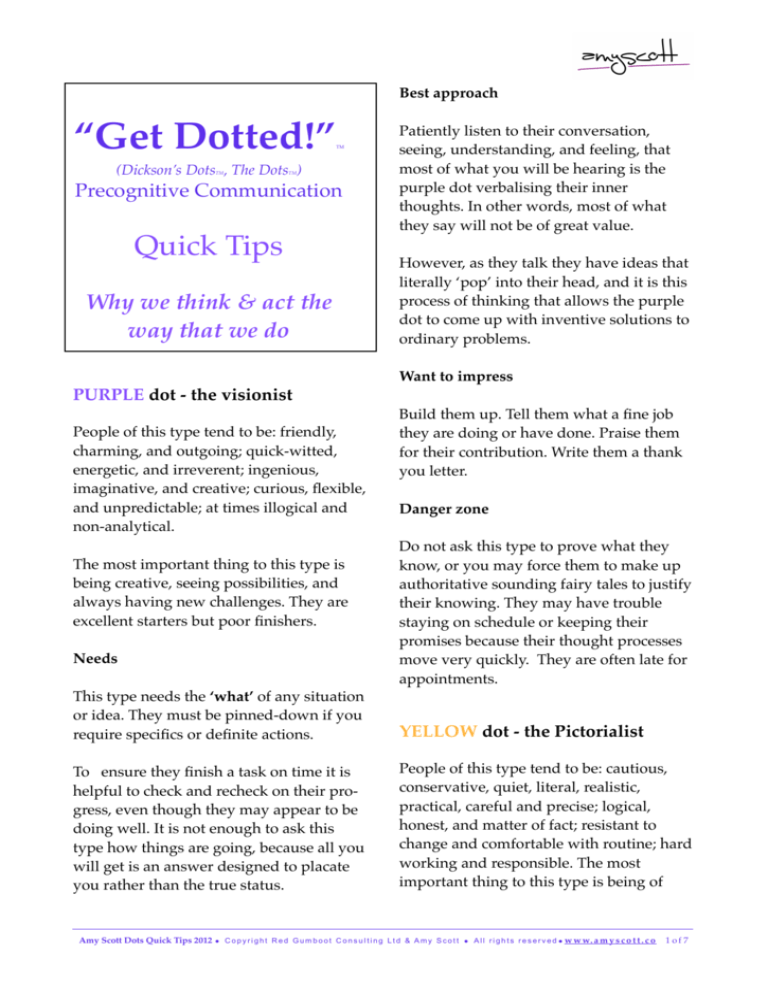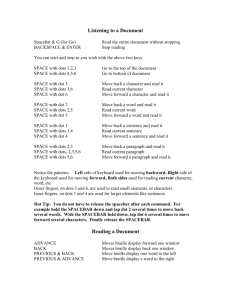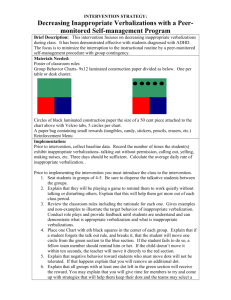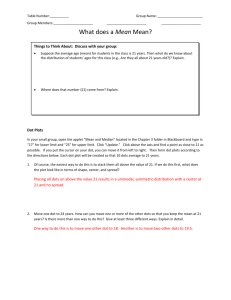AS DOTS QUICK TIPS 2012
advertisement

Best approach “Get Dotted!” TM (Dickson’s Dots , The Dots ) TM TM Precognitive Communication Quick Tips Why we think & act the way that we do Patiently listen to their conversation, seeing, understanding, and feeling, that most of what you will be hearing is the purple dot verbalising their inner thoughts. In other words, most of what they say will not be of great value. However, as they talk they have ideas that literally ‘pop’ into their head, and it is this process of thinking that allows the purple dot to come up with inventive solutions to ordinary problems. Want to impress PURPLE dot - the visionist People of this type tend to be: friendly, charming, and outgoing; quick-witted, energetic, and irreverent; ingenious, imaginative, and creative; curious, flexible, and unpredictable; at times illogical and non-analytical. The most important thing to this type is being creative, seeing possibilities, and always having new challenges. They are excellent starters but poor finishers. Needs Build them up. Tell them what a fine job they are doing or have done. Praise them for their contribution. Write them a thank you letter. Danger zone Do not ask this type to prove what they know, or you may force them to make up authoritative sounding fairy tales to justify their knowing. They may have trouble staying on schedule or keeping their promises because their thought processes move very quickly. They are often late for appointments. This type needs the ‘what’ of any situation or idea. They must be pinned-down if you require specifics or definite actions. YELLOW dot - the Pictorialist To ensure they finish a task on time it is helpful to check and recheck on their progress, even though they may appear to be doing well. It is not enough to ask this type how things are going, because all you will get is an answer designed to placate you rather than the true status. People of this type tend to be: cautious, conservative, quiet, literal, realistic, practical, careful and precise; logical, honest, and matter of fact; resistant to change and comfortable with routine; hard working and responsible. The most important thing to this type is being of Amy Scott Dots Quick Tips 2012 • C o p y r i g h t R e d G u m b o o t C o n s u l t i n g L t d & A m y S c o t t • A l l r i g h t s r e s e r v e d • w w w. a m y s c o t t . c o 1 of 7 service, working hard, and being responsible. Needs This type needs the ‘when’ of any situation or idea. It is best to give these type instructions in writing. As this type is very time-conscious there is little need to follow-up, however, should they require further information it is important that they get it quickly and in plenty of time to enable them to see where everything fits. Treat this type with respect and do not interfere with their personal organisation, such as meddling with their filing system or writing instructions that are not clear and concise. Best approach Patiently listen to their conversation, knowing, understanding, and feeling, that most of what you will be seeing is the yellow dot building mental pictures inside their head. Show patience and provide as much detail as possible when communicating. Always give this type time to make a decision. In other words, do not rush them; otherwise, they cannot build the clear and concise mental picture that they need to enable them to operate efficiently. Want to impress Danger zone Do not make promises to this type that you cannot keep. Do not lie or treat them as fools. When you arrange to meet, make sure you are on time. Dress neat and tidily. Do not mess with their schedule or make critical comments about their appearance or surroundings. RED dot - the rationalist People of this type tend to be: cautious and thoughtful; hesitant until they know people well then affectionate and caring; very literal and aware of the physical world; uncompromising about personal standards and easily offended; diligent and conscientious, organised and decisive. The most important thing to this type is living a stable, predictable life and helping people in real ways. Needs This type needs the ‘where’ of any situation or idea. They must be given the facts (the truth, the whole truth, and nothing but the truth). If they say they will finish a project on time then they will. If you provide them with too little information, they will respond by doing the same thing to you. Do something for them. Buy them a nice lunch at a good restaurant or purchase a quality publication, containing quality pictorial content. Write them a thank you letter, remembering to use high-quality stationery. Amy Scott Dots Quick Tips 2012 • C o p y r i g h t R e d G u m b o o t C o n s u l t i n g L t d & A m y S c o t t • A l l r i g h t s r e s e r v e d • w w w. a m y s c o t t . c o 2 of 7 Best approach Provide facts first, details last. Never lie to this type or treat them as a fool. If you make a promise to them keep it. Do not whinge, whine, make excuses, or attempt to use any form of emotional blackmail. Instead, be forthright and honest. Do not waffle or beat around the bush – this kind of communication they have trouble dealing with. important thing to this type is their relationships, and the opportunity to communicate and connect with others. Needs This type needs the ‘why’ of any situation or idea. They must be given information in a way that adds to their personal feelings of comfort and security. This means allowing them time to develop a ‘feeling’ for what you want them to do. Best approach Want to impress Respect is the key for this nature. A sincere thank you is appropriate. Buy them a gift such as a gift voucher, petrol voucher, a meal out etc. Ensure they are able to choose for themselves where they spend the windfall. Danger zone Do not lie or make excuses to this type. They might say nothing at the time but they will never forget or fully trust you again. Be kind, caring, considerate, and be fully aware of their need to get a feeling for what you want them to do. Speaking with sincerity, using a quiet tone will encourage them to listen and want to cooperate. Want to impress Let them know that you care, this must be sincere. A high-five or a pat on the shoulder can make a world of difference to how they feel. Tell them a good joke and have a good laugh. Danger zone Frills or fancy presentations seldom impress them – they just want the facts as they apply to them or to the project at hand. When this type says thank you, they mean it. BLUE dot - the sensationist People of this type tend to be: friendly, outgoing, and enthusiastic; affectionate articulate, and tactful; highly empathetic but easily hurt. They are productive, organised, and responsible. The most Never threaten or intimidate this type. Never attempt to make a fool of them or cause them to feel stupid. Keep your conversation friendly. Don’t push them to answer your questions should they choose to be quiet – they are usually processing thoughts and waiting to get a feeling for what is being said. Confrontation or a manner that is rude and insulting simply closes them down. Amy Scott Dots Quick Tips 2012 • C o p y r i g h t R e d G u m b o o t C o n s u l t i n g L t d & A m y S c o t t • A l l r i g h t s r e s e r v e d • w w w. a m y s c o t t . c o 3 of 7 Dealing with a “challenging” person. • Detail the rules for acceptable behaviour/productivity and give a timeline for expected improvement. Dealing with a PURPLE dot • Be prepared to acquiesce on a minor point and you will probably get cooperation on the other issues. Things to remember: • They are dreamers. They are great starters but poor finishers. They talk a lot (even to themselves). • Be clear and firm when communicating your displeasure. Questions are more effective than to “lecture”. • Keep the discussion to the errant behaviour/attitude rather than let it become personal. • • The purple dot will naturally be defensive and may appear arrogant. Let them know that they are a valuable member of the team when working well. Dealing with a RED dot Things to remember: • They have a logical approach to life. Becoming emotional will likely cause them to ignore you. You need to be sure of your facts. If you attack, the Rationalist will probably close down and simply ignore you. • Present the situation as it is. • Make sure you have some facts to base your discussion on. • Let them know that they are respected and that you are seeking a “win/win” resolution. Dealing with a YELLOW dot Things to remember: • • They are very time conscious. They can be highly critical (even about themselves). They naturally like to finish things and tend towards perfectionism. You’ll see that the Pictorialist will probably react and not listen. Let them have their say, giving them time to respond. They are likely to complain and then explain why they are complaining. Dealing with a BLUE dot Things to remember: • They have a strong tendency to take things personally. They often seek “approval”. They can go to extreme lengths to avoid confrontation. If you are confrontational with a Sensationist they will probably close down. • Don’t expect feedback or answers immediately. Give them time to get a feel for what you are saying. Amy Scott Dots Quick Tips 2012 • C o p y r i g h t R e d G u m b o o t C o n s u l t i n g L t d & A m y S c o t t • A l l r i g h t s r e s e r v e d • w w w. a m y s c o t t . c o 4 of 7 • Keep your discussion to the behaviour rather than make it personal. • Let them know that when functioning well, they are a valued member of the team. Precognitive Recipe for getting along with the different dots: Purple Be prepared to listen and offer regular praise Love Languages Remember criticism tears them down Visionist – purple dot Affirmations. Visionists thrive on applause. They need to ‘hear’ that they are good people. Criticism tears them down. Pictorialist – yellow dot Doing nice things. Pictorialists like pleasant surprises. They love it when you do something nice for them. They like attention (acts of service). Lack of appreciation can cause resentment. Rationalist – red dot Respect. Rationalists need honest appreciation, a gift of gratitude, a sincere thank you. Lack of appreciation can cause resentment. Sensationist – blue dot Sensationists need to feel you care. Criticism can close them down. Yellow Be prompt, listen patiently, be tidy, respectful and always keep your promises Remember criticism can cause defensive behaviour which could have negative consequences Red Understand they have a tendency to assume control Remember unfair criticism and lack of respect can anger them Blue Confrontation or a manner that is rude and insulting causes them to close down Remember criticism can cause them to lose confidence Amy Scott Dots Quick Tips 2012 • C o p y r i g h t R e d G u m b o o t C o n s u l t i n g L t d & A m y S c o t t • A l l r i g h t s r e s e r v e d • w w w. a m y s c o t t . c o 5 of 7 Picking Dots The first rule of picking dots is DON’T! It is not a useful habit to be going around trying to categorise people. The prime purpose of the information you are receiving today is to help you be better able to identify another person’s communication style so that you can get onto their wavelength more quickly. To discover a person’s dot, all you need do listen to that person and observe their manner. They will give you signals that will identify in which dot they are dominant. Feeling! Purple = Talkative, loud, fun, maybe over the top behaviour Blue = Quiet, pragmatic, caring, sensitive and strong Thinking ! Yellow = Talkative, immaculate grooming, coordinated clothing Red = Quiet, practical dresser, communicates in phrases (almost bullet points) Listening will reveal: Purple ! ! Yellow ! Red ! Blue ! = “I know” = “I see” = “I understand” = “I feel” What each dot always wants to know: There are two types of dots: Feeling (Purple & Blue) Thinking (Yellow & Red) Purple!! Yellow! Red! ! Blue ! ! = “What” = “When” = “Where” = “Why” How can you tell if a person is a feeling? They will probably appear relaxed. How can you tell if a person is a thinking? They will probably appear intense. Once you have established feeling or thinking, it becomes easier: Notice how different they are. For more information or to get Amy Scott to “excite, delight, entertain & educate” on how not to “rub people up the wrong way”.... please get in touch with Amy today on amy@amyscott.co +64 27 3688 464 www.facebook.com/amyscottspeaker www.amyscott.co www.twitter.com/AmyScottSpeaker Amy Scott Dots Quick Tips 2012 • C o p y r i g h t R e d G u m b o o t C o n s u l t i n g L t d & A m y S c o t t • A l l r i g h t s r e s e r v e d • w w w. a m y s c o t t . c o 6 of 7 Attitude is everything! The longer we live, the more we realise the impact of attitude on life. Attitude is more important than facts. It is more important than the past, than education, than money, than circumstances, than failures, than successes, than what other people think or say or do. It is more important than appearance, physical strength or skill. It will make or break a company … a church … a home. The remarkable thing is we have a choice every day regarding the attitude we will embrace for that day. We cannot change the past; we can only affect the future. We cannot change the fact that people will act in a certain way. We cannot change the inevitable. The only thing we can do is decide what our attitude will be. Life is 10% what happens to us and 90% how we react to it. Our attitude is the most vulnerable part of our existence – it is also the only part of our existence over which we have total control. Our attitude is everything! Amy Scott Dots Quick Tips 2012 • C o p y r i g h t R e d G u m b o o t C o n s u l t i n g L t d & A m y S c o t t • A l l r i g h t s r e s e r v e d • w w w. a m y s c o t t . c o 7 of 7









